When it comes to tackling various tasks around the home and garage, one product stands out for its versatility and effectiveness – WD-40. This household name has been a trusted solution for decades, offering a wide range of uses that can make your life easier. Whether you need to lubricate hinges, remove rust, or protect metal surfaces, WD-40 has got you covered.
So, what exactly can you accomplish with WD-40? In this article, we will explore the numerous uses of WD-40 and how it can be your go-to solution for multiple projects. From lubricating door locks to removing adhesive residue, we will cover it all. Your home and garage will never be the same once you discover the power of WD-40.
Key Takeaways:
- WD-40 is a versatile product that can be used for a wide range of tasks around the home and garage.
- It is effective in lubricating hinges, removing rust, cleaning tools, and protecting metal surfaces.
- WD-40 can also be used to loosen stuck mechanisms, remove adhesive residue, prevent snow and ice buildup, and restore faded plastic.
- There are even unconventional uses of WD-40 that you may not be aware of.
- By using WD-40, you can save time, effort, and money on various projects.
Lubricating Hinges and Door Locks with WD-40
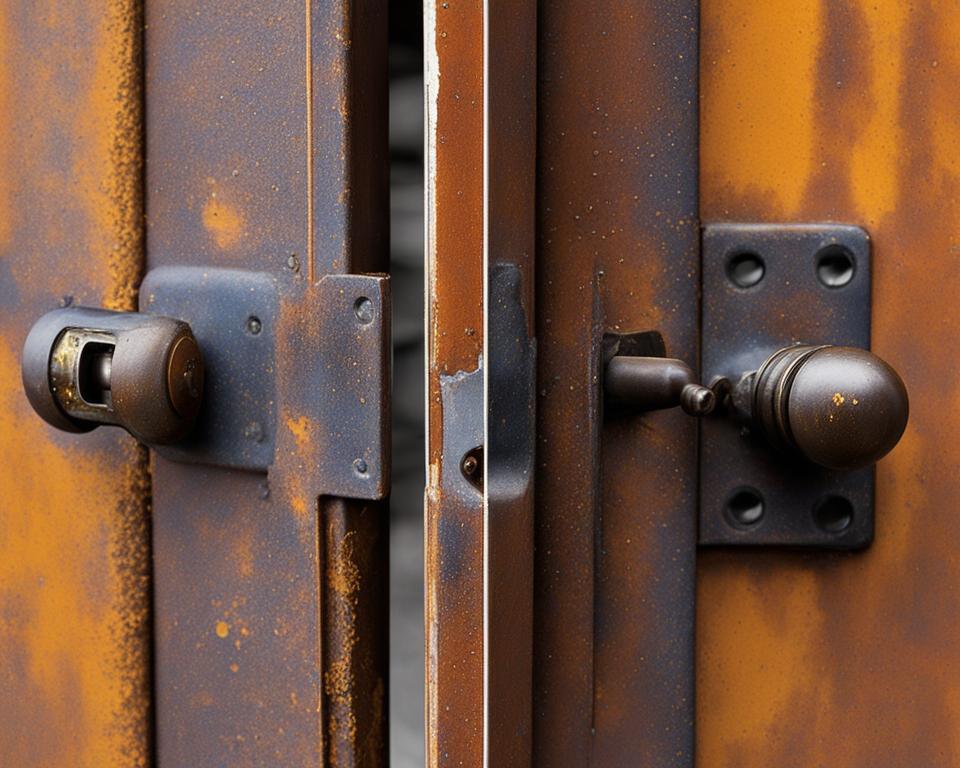
When it comes to maintaining smooth operation and extending the lifespan of your hinges and door locks, WD-40 is a versatile and reliable solution. This section will guide you through the process of effectively lubricating squeaky hinges and stiff door locks using WD-40.
Step-by-Step Guide:
- Start by cleaning the hinges and door locks with a mild detergent and warm water solution. This will remove any dirt, dust, or debris that may hinder the lubrication process.
- Dry the hinges and locks thoroughly using a clean cloth or paper towel.
- Shake the WD-40 can well before use to ensure proper mixing.
- Spray a small amount of WD-40 onto the hinges, targeting the pivot points and moving parts. Be sure to cover the entire surface evenly.
- Gently move the hinges or locks back and forth to allow the lubricant to penetrate and distribute evenly.
- If necessary, use a clean cloth to wipe away any excess WD-40.
By following these simple steps, you can effectively lubricate hinges and door locks, ensuring smooth and hassle-free operation. WD-40’s lubricating properties will reduce friction and prevent rust and corrosion, prolonging the life of your hinges and locks.
Remember, regular maintenance and lubrication are essential to keep your hinges and door locks in optimal condition.
Next, let’s move on to the fascinating topic of removing rust with WD-40. Discover how this versatile product can help you tackle stubborn rust and restore your tools and equipment.
Removing Rust with WD-40
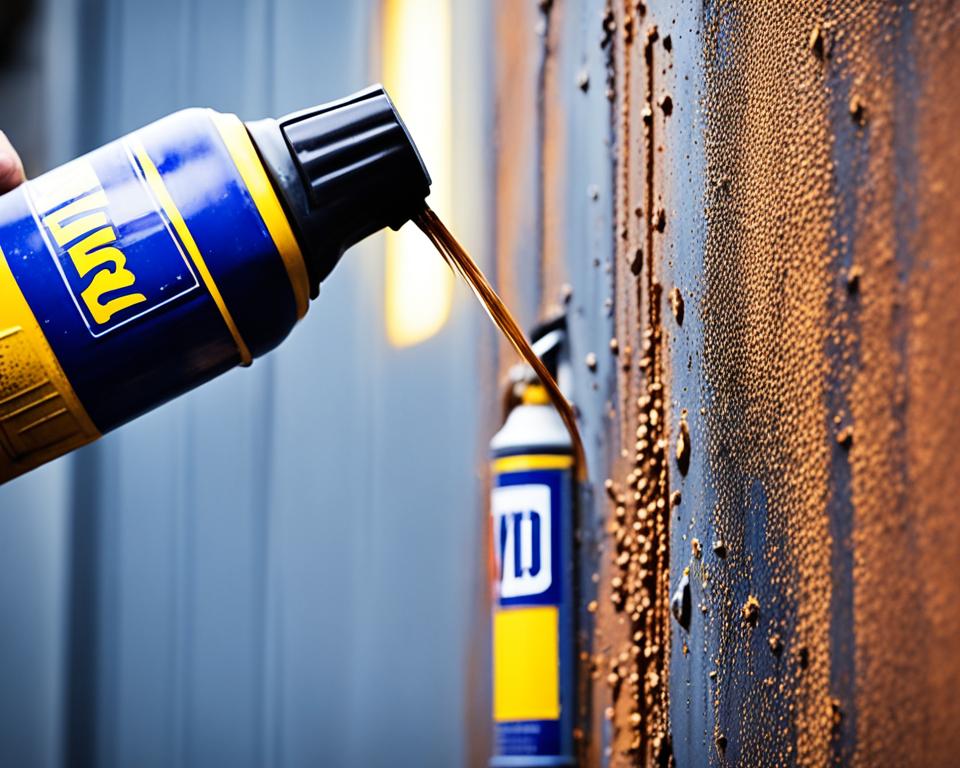
Rust can be a stubborn and unsightly problem, but with WD-40, you have a powerful rust removal solution at your fingertips. This versatile product not only helps penetrate rust but also loosens stuck bolts, nuts, and fittings. With WD-40, you can tackle rust-related issues with ease and restore the functionality of your metal items.
How does WD-40 remove rust?
WD-40’s rust-removing properties are attributed to its unique formula that helps loosen rust particles and break down corrosion. When applied to rusty surfaces, WD-40 seeps into the tightest of crevices, displaces moisture, and starts the rust removal process.
WD-40’s rust removal is particularly effective due to its ability to:
- Penetrate rust: WD-40’s thin consistency allows it to penetrate the tightest rust-prone areas, ensuring maximum coverage and effectiveness.
- Loosen rusted parts: WD-40’s lubricating properties help loosen the grip of rusted bolts, nuts, and fittings, making them easier to remove.
- Prevent further corrosion: By displacing moisture and leaving a protective barrier, WD-40 helps prevent future rust formation, keeping your metal items in good condition.
Using WD-40 for rust removal
When using WD-40 to remove rust, follow these steps for optimal results:
- Preparation: Ensure the rusty surface is clean and free from loose debris. Use a wire brush or sandpaper to remove any loose rust or flaking paint.
- Apply WD-40: Spray WD-40 directly onto the rusted area, ensuring thorough coverage. Allow it to sit for a few minutes to penetrate the rust.
- Scrub or brush: Use a wire brush, old toothbrush, or abrasive pad to gently scrub the rusted surface. This helps dislodge rust particles and expose the underlying metal.
- Wipe clean: After scrubbing, use a clean cloth or paper towel to wipe away the loosened rust and excess WD-40.
- Repeat if necessary: For more severe rust, repeat the process until the rust is completely removed. Stubborn rust may require multiple applications.
- Maintenance: To prevent future rust formation, consider applying a protective coating, such as paint or a rust inhibitor, to the treated metal surface.
Remember, the effectiveness of WD-40 may vary depending on the severity of the rust and the type of metal. It is always recommended to test a small, inconspicuous area before treating the entire surface.
| Benefits of using WD-40 for rust removal: |
|---|
| Effective rust penetration |
| Loosens stuck bolts, nuts, and fittings |
| Prevents future rust formation |
| Versatile and easy-to-use |
| Can be used on various metal surfaces |
WD-40 is not only a rust remover but also a preventive solution. By regularly using WD-40 on your metal items, you can help protect them from rust and extend their lifespan.
Cleaning and Polishing Tools with WD-40

When it comes to maintaining your tools and keeping them in top condition, WD-40 is a versatile product that can be your go-to solution. Not only is it great for lubricating hinges and loosening rusted parts, but it is also an excellent tool cleaner and polisher. Whether you have a collection of hand tools or power tools, WD-40 can help you remove grime, grease, and dirt, restoring your tools to their former glory.
Best Practices for Cleaning Tools
When it comes to cleaning your tools, it’s important to use the right techniques to ensure you don’t damage them in the process. Here are some best practices to follow:
- Start with a dry brush: Before applying WD-40, use a dry brush to remove any loose debris or dirt from your tools.
- Apply WD-40: Once your tools are free from loose dirt, spray WD-40 directly onto the surface you want to clean. The WD-40 will penetrate deep into the grime and make it easier to remove.
- Scrub and wipe: Use a clean cloth or brush to scrub the surface and remove the grime. For stubborn stains, you can let the WD-40 sit for a few minutes before scrubbing.
- Rinse and dry: After cleaning, rinse your tools with water to remove any remaining WD-40 and grime. Dry them thoroughly to prevent rusting.
Polishing Tools with WD-40
WD-40 is not only great for cleaning tools, but it can also be used to polish them and restore their shine. Here’s how to do it:
- Clean the surface: Before polishing, make sure the surface is clean and free from dirt or grime.
- Apply WD-40: Spray WD-40 onto a clean cloth or directly onto the surface you want to polish.
- Buff the surface: Using the cloth, buff the surface in a circular motion. The WD-40 will help remove any stains, scratches, or oxidation, leaving your tools looking like new.
- Wipe off any excess: Once you’re done polishing, wipe off any excess WD-40 with a clean cloth.
Remember to always follow safety precautions and use WD-40 in a well-ventilated area. Avoid spraying it near open flames and be cautious of any potential skin or eye contact.
Benefits of Using WD-40 for Tool Cleaning and Polishing
Using WD-40 for cleaning and polishing your tools offers several benefits:
| Benefits | |
|---|---|
| 1. Removes grime, grease, and dirt effectively | |
| 2. Restores shine and appearance | |
| 3. Helps prevent rust and corrosion | |
| 4. Versatile tool cleaner for a wide range of materials |
By regularly cleaning and polishing your tools with WD-40, you can extend their lifespan, improve their performance, and ensure they are always ready for your next project.
Protecting Metal Surfaces with WD-40
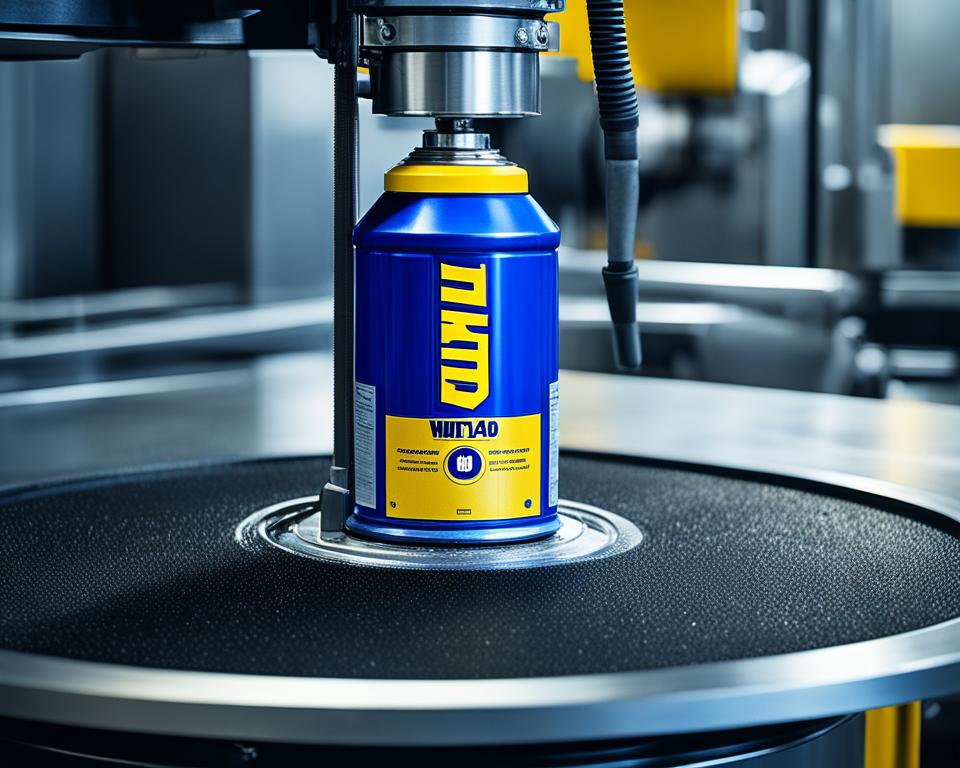
When it comes to safeguarding your metal surfaces from corrosion and damage, WD-40 is a trusty companion. This versatile product can be used as a protective coating, providing a barrier that prevents moisture and other corrosive elements from compromising the integrity of your metal belongings.
To ensure long-lasting metal protection, follow these simple steps:
- Start by cleaning the metal surface thoroughly to remove any dirt, grime, or rust using a mild detergent and water.
- Once the surface is clean and dry, apply a thin layer of WD-40 using a clean cloth or a spray bottle.
- Make sure to cover the entire metal surface evenly, paying extra attention to any nooks, crannies, or hard-to-reach areas.
- Allow the WD-40 to penetrate the metal surface for a few minutes.
- Finally, use a clean cloth to gently wipe away any excess WD-40, leaving behind a protective layer.
This protective coating acts as a shield, guarding your metal surfaces against moisture, rust, and other corrosive elements. Whether it’s outdoor furniture, garden tools, or metal appliances, WD-40 can help extend their lifespan and keep them looking their best.
Remember: Always perform a patch test on a small, inconspicuous area before applying WD-40 to the entire metal surface to ensure compatibility and avoid any potential damage.
Advantages of Using WD-40 for Metal Protection:
By utilizing WD-40 for metal protection, you can reap the following benefits:
- Corrosion prevention: WD-40 forms a protective barrier that inhibits the formation of rust and other corrosive damage.
- Enhanced durability: The protective coating provided by WD-40 helps extend the lifespan of your metal belongings, reducing the need for frequent replacements.
- Improved appearance: With regular application of WD-40, your metal surfaces will maintain their original luster and look as good as new.
- Ease of application: WD-40 is user-friendly, making it easy for anyone to apply and protect their metal surfaces.
So, whether it’s your prized antique brass collection or your outdoor metal patio furniture, WD-40 can be your go-to solution for protecting and preserving your valuable metal belongings.
Comparison of WD-40 and Traditional Metal Protective Coatings
| Aspects | WD-40 | Traditional Metal Coatings |
|---|---|---|
| Level of Protection | Provides a strong protective barrier against moisture and corrosion. | May offer varying levels of protection but can be less effective against certain corrosive elements. |
| Application Process | Simple and easy, can be applied using a cloth or spray bottle. | Often requires specialized equipment and expertise for proper application. |
| Cleaning Requirements | Minimal cleaning required before application. | May require extensive cleaning and preparation to ensure optimal adhesion. |
| Cost | Cost-effective solution for metal protection. | Can be expensive, especially when considering application equipment and labor costs. |
| Versatility | WD-40 can be used on a wide range of metal surfaces. | Traditional coatings may have limitations in terms of surface compatibility. |
Loosening Stuck Mechanisms with WD-40

If you’ve ever struggled with a stuck zipper or a stubborn nut and bolt, you’ll know just how frustrating it can be. Fortunately, WD-40 is here to save the day. This versatile product is not only great for lubricating hinges and removing rust, but it’s also incredibly effective at loosening stuck mechanisms.
When it comes to loosening stuck zippers, WD-40 is your secret weapon. Simply spray a small amount onto the stuck area and gently maneuver the zipper back and forth. The lubricating properties of WD-40 will work their magic, making it easier to zip up your favorite jacket or bag.
For stuck nuts and bolts, WD-40 can be a game-changer. Apply WD-40 to the affected area and let it sit for a few minutes. The WD-40 will penetrate the rust and grime, loosening the mechanism and making it easier to remove. Say goodbye to the frustration of stripped screws or seized nuts!
Techniques for Using WD-40 on Stuck Mechanisms:
- Always apply WD-40 in a well-ventilated area to avoid inhaling fumes.
- Use the included straw attachment to target hard-to-reach areas.
- Apply a generous amount of WD-40 and allow it to penetrate the mechanism for a few minutes before attempting to move or loosen it.
- For particularly stubborn mechanisms, you may need to repeat the process or use a combination of WD-40 and gentle force.
- Remember to wipe away any excess WD-40 after loosening the mechanism to prevent it from attracting dirt or debris.
“WD-40 has been a lifesaver for me when it comes to getting unstuck. I recently had a zipper on my favorite jacket that wouldn’t budge, no matter how hard I pulled. A few sprays of WD-40 and some gentle jiggling, and it was as good as new!” – Mary, DIY enthusiast
Next time you find yourself dealing with a stuck zipper, nut, or bolt, reach for a can of WD-40. Its powerful combination of lubricating and penetrating properties will help you tackle even the most stubborn mechanisms with ease.
| Common Stuck Mechanisms | WD-40 Solution |
|---|---|
| Zippers | Apply a small amount of WD-40 to the stuck area and gently maneuver the zipper back and forth. |
| Nuts and Bolts | Apply WD-40 to the affected area and let it sit for a few minutes before attempting to remove the mechanism. |
| Door Latches | Spray WD-40 onto the latch mechanism and gently work it back and forth to loosen it. |
| Stuck Locks | Apply WD-40 to the keyhole and wiggle the key gently to free up the lock mechanism. |
With WD-40 in your toolbox, you can confidently tackle any stuck mechanism that comes your way. From zippers and nuts to door latches and locks, WD-40 will have things moving smoothly in no time.
Removing Adhesive Residue with WD-40

Adhesive residue can be notoriously difficult to remove, but with WD-40, it becomes a breeze. This versatile product can effectively dissolve and eliminate sticky remnants from various surfaces, saving you time and frustration.
When using WD-40 for adhesive removal, it’s important to follow these steps:
- Preparation: Start by ensuring the surface is clean and dry. Remove any loose adhesive or debris before applying WD-40.
- Application: Spray WD-40 directly onto the adhesive residue, making sure to cover it thoroughly. Allow the product to penetrate and loosen the residue for a few minutes.
- Scrubbing: Use a soft cloth or sponge to gently scrub the area in circular motions. The adhesive should start to dissolve and come off easily.
- Rinsing: Once the residue is removed, rinse the surface with warm soapy water to remove any remaining WD-40 and adhesive traces.
- Drying: Finally, dry the surface completely with a clean cloth or towel.
It’s essential to take precautions when using WD-40 for adhesive removal:
- Testing: Before applying WD-40 to a large or sensitive area, test it on a small, inconspicuous spot to ensure it doesn’t damage or discolor the surface.
- Ventilation: Always work in a well-ventilated area to avoid inhaling fumes. If necessary, use a mask or protective gear.
- Surface Compatibility: While WD-40 is safe on most surfaces, it’s advisable to check the manufacturer’s recommendations for any specific materials or finishes, especially delicate or sensitive surfaces.
Removing adhesive residue is no longer a laborious task when you have WD-40 at your disposal. Its powerful formula effortlessly dissolves sticky remnants, making cleanup a breeze.
| Benefits of Using WD-40 for Adhesive Removal | Drawbacks of Using WD-40 for Adhesive Removal |
|---|---|
| 1. Effectively dissolves adhesive residue. | 1. May have a strong odor. |
| 2. Versatile and suitable for various surfaces. | 2. May require multiple applications for stubborn residue. |
| 3. Easy application process. | 3. Can leave behind an oily residue. |
| 4. Time-saving solution. | 4. Not recommended for use on certain plastics or painted surfaces. |
Preventing Snow and Ice Buildup on Surfaces with WD-40
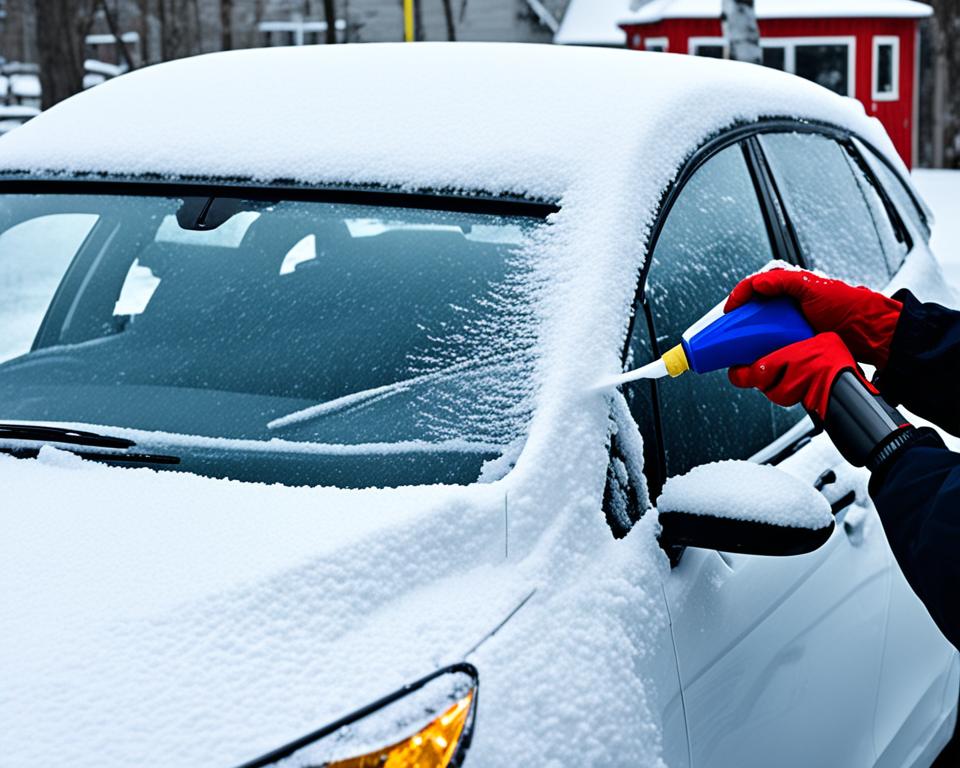
When winter arrives, preventing snow and ice buildup on surfaces becomes a top priority for homeowners and property managers. The last thing anyone wants is slippery walkways, dangerous driveways, or damaged roofs and gutters. Fortunately, WD-40 comes to the rescue with its snow and ice prevention capabilities.
WD-40 acts as a barrier, preventing snow and ice from adhering to surfaces. Its unique formula creates a slippery film that keeps snow and ice from accumulating, making it easier to remove and reducing the risk of accidents.
So how can you use WD-40 to prevent snow and ice buildup on different surfaces? Here are some practical tips:
- Treating snow shovels: Before tackling snow removal, spray WD-40 on your snow shovel blade. This will help prevent snow from sticking to the shovel, allowing for easier and more efficient snow clearing.
- Applying to windows and windshields: To prevent snow and ice from forming on your windows and windshields, spray a thin layer of WD-40 and wipe it off with a clean cloth. This will minimize the buildup and make snow and ice removal a breeze.
- Coating walkways and driveways: Spray WD-40 on walkways and driveways to create a protective barrier before the snowfall. This will help prevent snow from bonding to the surface and minimize the need for heavy shoveling or de-icing.
Remember to apply WD-40 in a well-ventilated area and avoid spraying it on surfaces sensitive to oil. It’s also essential to follow the instructions on the WD-40 canister and take necessary safety precautions.
“Using WD-40 to prevent snow and ice buildup is a game-changer. It saves time and effort during winter maintenance tasks and ensures safer surfaces for everyone.”
With WD-40’s snow and ice prevention properties, you can confidently face winter weather knowing that you have an effective solution to minimize snow buildup and keep surfaces clear.
Restoring Faded Plastic with WD-40
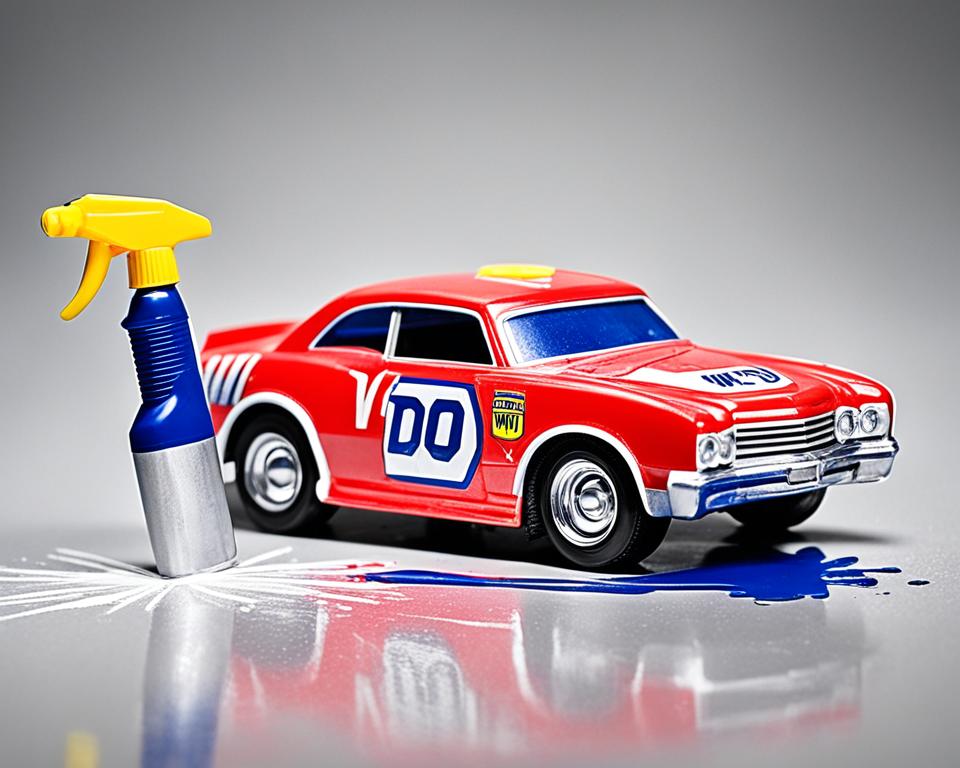
If you have faded and dull-looking plastic items around your home or in your car, WD-40 can be a game-changer. This versatile product is not only excellent for lubrication and rust removal, but it can also bring back the vibrant color and shine to your plastic surfaces.
Using WD-40 for plastic restoration is a simple and effective solution. Here are a few techniques and tips to help you restore faded plastic:
- Clean the surface: Before restoring the plastic, ensure that it’s clean and free from any dirt or debris. Use a mild soap and water solution to gently wash the surface, and then dry it thoroughly.
- Apply a small amount of WD-40: Spray WD-40 onto a clean cloth or sponge, then gently rub it onto the faded plastic surface. Start with a small area to test the results before proceeding to larger areas.
- Let it sit: After applying WD-40, allow it to sit on the plastic surface for a few minutes. This gives the product time to penetrate the surface and work its magic.
- Buff the surface: Using a clean, dry cloth, gently buff the plastic surface in circular motions. This will help spread the WD-40 evenly and restore the shine to the faded plastic.
- Repeat if necessary: For heavily faded plastic, you may need to repeat the process a few times to achieve the desired results. Take your time and be patient, and you’ll be amazed at the transformation.
WD-40 can be used on a variety of plastic items, such as outdoor furniture, car interiors, and household appliances. However, it’s always a good idea to test a small, inconspicuous area before applying WD-40 to the entire surface.
Remember to follow safety precautions and use WD-40 in a well-ventilated area. It’s also advisable to wear gloves to protect your hands during the restoration process.
Tip: To maintain the restored plastic, periodically clean it with a mild soap and water solution. This will help prevent future fade and keep the plastic looking vibrant and fresh.
So, if you have faded plastic items that are in need of a makeover, don’t throw them away just yet. Try restoring them with WD-40, and you’ll be amazed at the results.
| Step | Technique |
|---|---|
| 1 | Clean the surface |
| 2 | Apply a small amount of WD-40 |
| 3 | Let it sit |
| 4 | Buff the surface |
| 5 | Repeat if necessary |
Unusual Uses of WD-40

While WD-40 is commonly known for its versatility in household and garage projects, it also boasts a range of unconventional uses that may surprise you. Let’s explore some of these unique applications where WD-40 can come in handy:
Silencing Squeaky Shoes
Do you have a pair of squeaky shoes that disrupt your every step? WD-40 can help! Simply spray a small amount of WD-40 on the areas where the shoes rub together, such as the tongue or heel, and let it dry. The lubricating properties of WD-40 will eliminate the squeak, allowing you to walk confidently and without noise.
Removing Crayon Marks from Walls
If you have children who love expressing their artistic talents on the walls, WD-40 can be your secret weapon. Spray a small amount of WD-40 directly on the crayon marks and let it sit for a few minutes. Then, wipe the marks away with a clean cloth or sponge. The crayon marks will disappear, leaving your walls looking clean and pristine.
Untangling Jewelry Chains
We’ve all experienced the frustration of tangled jewelry chains. But fear not, as WD-40 can help you untangle those knots. Apply a small amount of WD-40 to the tangled chain and gently work it with a pair of needles or toothpicks. The lubricating properties of WD-40 will loosen the knots, making it easier to untangle the chain without damaging it.
Removing Stickers and Labels
Stickers and labels can be stubborn to remove, especially when they leave behind sticky residue. WD-40 can effectively dissolve the adhesive, making sticker removal a breeze. Spray WD-40 on the sticker or label, wait a few minutes, and then peel it off. If any residue remains, simply wipe it away with a cloth. Your surfaces will be sticker-free and residue-free.
Polishing Stainless Steel
If you have stainless steel appliances or fixtures that are looking dull or smudged, WD-40 can bring back their shine. Spray a small amount of WD-40 on a clean cloth and buff the stainless steel surface in circular motions. WD-40 will remove fingerprints, smudges, and stains, leaving your stainless steel looking brand new and gleaming.
“WD-40’s unconventional uses expand beyond its primary applications, offering practical solutions for everyday challenges.”
These are just a few examples of the unusual uses of WD-40. From silencing squeaky shoes to removing stubborn stickers, WD-40’s versatility extends beyond its conventional uses. It’s a handy product to have around the house for tackling a wide range of unexpected situations.
Conclusion
In conclusion, WD-40 is a versatile and highly effective solution for a wide range of home and garage projects. Throughout this article, we have explored its many uses, from lubricating hinges and door locks to removing rust and cleaning tools.
With WD-40, you can effortlessly protect metal surfaces, loosen stuck mechanisms, and even remove stubborn adhesive residue. It is also a handy tool for preventing snow and ice buildup and restoring faded plastic items.
Whether you need a quick fix or a long-lasting solution, WD-40 has proven to be a reliable and indispensable companion. Its ability to tackle various tasks efficiently makes it a go-to product for DIY enthusiasts, homeowners, and professionals alike. So next time you encounter a problem, remember the versatility of WD-40 and how it can make your projects smoother and easier.
FAQ
What are the uses of WD-40?
WD-40 has a wide range of uses. It can be used for lubricating hinges and door locks, removing rust, cleaning and polishing tools, protecting metal surfaces, loosening stuck mechanisms, removing adhesive residue, preventing snow and ice buildup, restoring faded plastic, and even for some unusual and unconventional purposes.
How can I lubricate hinges and door locks with WD-40?
To lubricate hinges and door locks with WD-40, spray a small amount directly onto the hinge pivot points or the lock mechanism. Then, open and close the hinges or lock several times to distribute the lubricant evenly. This will help eliminate squeaks and ensure smooth operation.
Can WD-40 be used to remove rust?
Yes, WD-40 is effective in removing rust. Simply spray WD-40 onto the rusted area and let it penetrate for a few minutes. Then, use a wire brush or cloth to scrub off the rust. Repeat the process if necessary. WD-40 can also help loosen rusted bolts, nuts, and fittings.
How do I clean and polish tools with WD-40?
To clean and polish tools with WD-40, spray a small amount onto the tool’s surface and let it sit for a few minutes. Using a cloth or brush, scrub away any grime, grease, or dirt. For stubborn stains, you may need to repeat the process. WD-40 can help restore tools to their original shine.
Can WD-40 protect metal surfaces?
Yes, WD-40 can protect metal surfaces from corrosion and damage. To apply WD-40 as a protective coating, spray a thin layer onto the metal surface and spread it evenly. This will help prevent moisture from reaching the metal and causing rust. Regular application can provide long-lasting metal protection.
How can WD-40 loosen stuck mechanisms?
WD-40 can effectively loosen stuck mechanisms such as zippers, nuts, and bolts. Simply spray a small amount of WD-40 onto the stuck area and wait for a few minutes. Then, gently try to move or open the mechanism. The lubricating properties of WD-40 will help free up the stuck parts.
Is WD-40 helpful in removing adhesive residue?
Yes, WD-40 can be a handy solution for removing stubborn adhesive residue. Apply a small amount of WD-40 onto the residue and let it sit for a few minutes. Then, gently rub the area with a cloth or sponge to loosen and remove the adhesive. Be sure to test it on a small, inconspicuous area first.
Can WD-40 prevent snow and ice buildup?
Yes, WD-40 can help prevent snow and ice buildup on various surfaces. Before the winter season, spray a thin layer of WD-40 onto surfaces prone to snow and ice buildup, such as sidewalks or car windows. This can create a barrier that makes it easier to remove snow and ice, reducing the risk of accidents.
How can WD-40 restore faded plastic?
WD-40 can revitalize and restore faded plastic items. Apply a small amount of WD-40 onto the faded plastic surface and rub it in gently with a cloth or sponge. The WD-40 will help restore the color and shine of the plastic, making it look new again. Remember to test it on a small, inconspicuous area first.
Are there any unusual uses of WD-40?
Yes, there are several unusual and unconventional uses for WD-40. It can be used to remove crayon marks from walls, remove scuff marks from floors, remove stickers or labels, clean stainless steel surfaces, prevent snow from sticking to shovels, and even remove chewing gum from hair. WD-40’s versatility extends beyond traditional applications.




